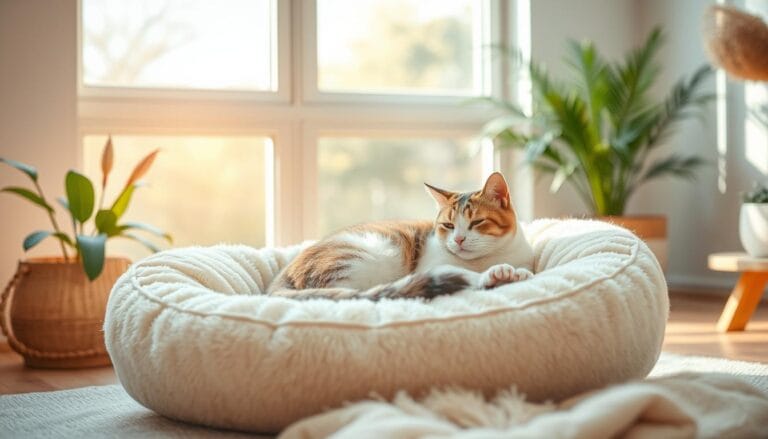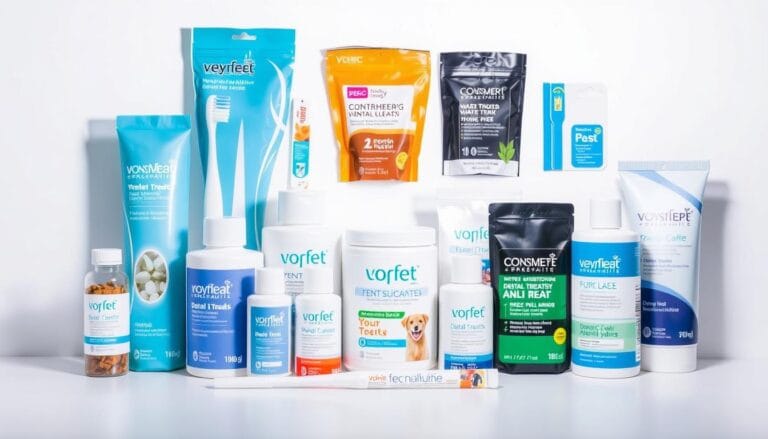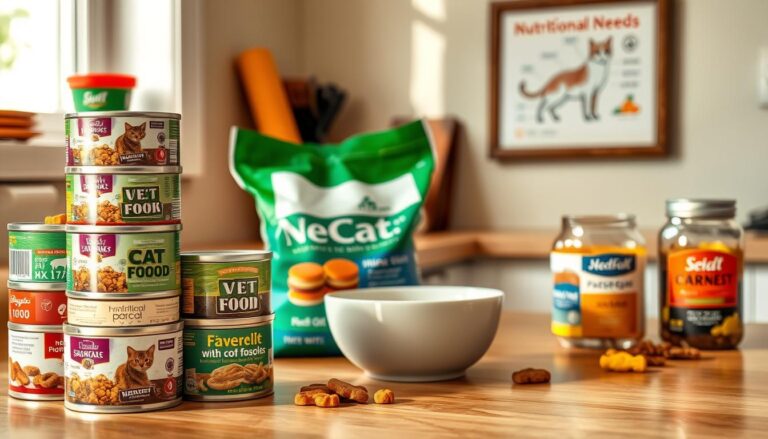What Veggies Can Cats Eat Safely? Top 10 Essential Vet-Approved Picks
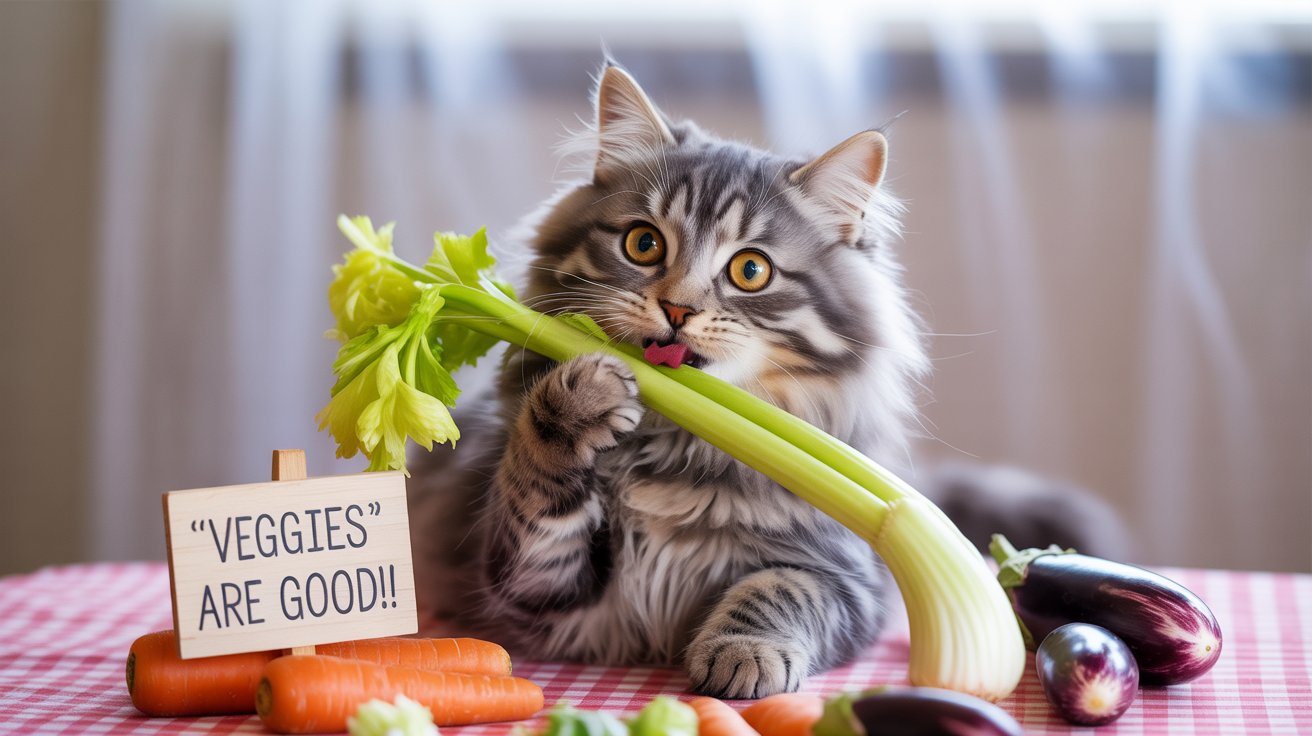
As a cat owner, you want the best for your feline friend. This includes a diet that’s both nutritious and safe. What veggies can cats eat? While cats are meat-eaters, some veggies can be good for them. But, not all veggies are safe for cats.
Some veggies can be toxic, while others are good for them. What veggies can cats eat safely? It’s important to know which vegetables are safe for cats to eat. This article will show you the top 10 vet-approved veggies that are safe for your cat. This will help you make better choices for their diet.
Table of Contents
Cats and Vegetables: Setting the Stage
Cats are meat lovers, but some think veggies can be good for them. What veggies can cats eat to get extra nutrients? While it might sound strange, some veggies can give cats important nutrients and health perks.
The Carnivore Conundrum
Cats love meat, which makes adding veggies a bit odd. What veggies can cats eat without harming their health? Yet, some veggies can help with health issues. For example, fiber-rich veggies can help with digestion.
Key considerations:
- Not all vegetables are safe for cats.
- Some cats may have allergies or sensitivities.
- Vegetables should complement, not replace, their primary diet.
Benefits of Adding Vegetables to Your Cat’s Diet
Choosing the right veggies can boost your cat’s nutrition. What veggies can cats eat to stay healthy and fit? Carrots and green beans are good because they’re low in calories but full of vitamins. Dr. Jane Smith, a vet, says, “Adding veggies to a cat’s diet can help with weight and overall health.”
| Vegetable | Nutritional Benefit |
|---|---|
| Carrots | Rich in Vitamin A |
| Green Beans | Low in calories, high in fiber |
“The right vegetables can make a significant difference in a cat’s health and wellbeing.”
Understanding Your Cat’s Nutritional Needs
Cats need a special mix of nutrients to stay healthy. Since they are obligate carnivores, they mainly get what they need from animal products. Knowing what they need helps cat owners choose the right food for them.
Obligate Carnivores: What This Means
Cats are built to eat a lot of protein from animals. Their bodies are made to digest lots of protein and fat from meat. This makes animal products key to their diet.
The Role of Plant Matter in Feline Diets
Even though cats are meat-eaters, some veggies are good for them. What veggies can cats eat without causing harm? Cat-friendly vegetables like cooked carrots and green beans can be added in small amounts. They bring fiber, vitamins, and minerals that are good for cats.
But, it’s important to remember that veggies should not be the main part of a cat’s diet. What veggies can cats eat as a safe supplement? Talking to a vet can help figure out how to add veggies safely to their meals.
What Veggies Can Cats Eat: Understanding Feline Nutrition
It’s important to know which vegetables are safe for cats. Cats are meat-eaters, but some veggies can be good for them too.
Digestive Limitations in Cats
Cats have a special way of digesting food. They mainly eat protein from meat. What veggies can cats eat since they can’t digest a lot of carbs found in veggies?
Still, some veggies can be good for cats. They can add fiber, vitamins, and minerals to their diet.
Nutritional Benefits: What Veggies Can Cats Eat for Better Health
Cats don’t need veggies as their main food. But, what veggies can cats eat that are beneficial? For example, green beans and peppers are low in calories and full of fiber.
Other veggies like pumpkin and sweet potatoes have vitamins and minerals. What veggies can cats eat to boost their health? These can help keep cats healthy and happy.
What Veggies Can Cats Eat? Carrots: A Crunchy Vitamin A Powerhouse
What veggies can cats eat? Carrots are a great choice for cats because they’re full of vitamin A. This vitamin is key for a cat’s vision, immune system, and skin. Adding carrots to a cat’s diet in small amounts can be healthy.
Nutritional Benefits for Cats
Carrots are packed with vitamin A, which fights off cell damage. Vitamin A is also vital for a cat’s eyes and immune system. Plus, they have fiber, which helps with digestion.
How to Serve Carrots to Your Cat
To safely give carrots to your cat, cook them first. Steaming or boiling until tender is best. Make sure to chop or grate them to avoid choking. Start with small amounts to watch for any bad reactions.
Source: https://www.thesprucepets.com/can-cats-eat-carrots-8687488
What Veggies Can Cats Eat? Pumpkin: The Digestive Health Superstar
What veggies can cats eat to support digestion? Pumpkin is a top pick for feline-friendly veggies. It’s great for cats with digestive problems. Pumpkin is full of fiber and nutrients that help with digestion.
How Pumpkin Helps Feline Digestion
Pumpkin’s fiber helps keep bowel movements regular. This is good for cats with constipation. It also has both types of fiber to firm up loose stool and prevent diarrhea.
The fiber in pumpkin feeds good bacteria in the gut. A healthy gut is key for digestion and helps your cat absorb nutrients better.
Serving Suggestions and Portions
To give pumpkin to your cat, cook and mash it. Or use plain canned pumpkin. Start with 1-2 teaspoons mixed into their meals. Slowly add more as advised by your vet.
| Cat Weight (lbs) | Pumpkin Serving Size (tsp) |
|---|---|
| Under 5 | 1/4 to 1/2 |
| 5-10 | 1/2 to 1 |
| Over 10 | 1 to 2 |
Source: https://www.thesprucepets.com/can-cats-eat-pumpkin-8704796
What veggies can cats eat? Green Beans: Low-Calorie Feline Treats
What veggies can cats eat to stay fit and healthy? Green beans are safe for cats to eat. They are a low-calorie snack that helps with weight management. They also have lots of fiber, which is good for digestion.
Cats like the crunchy texture of green beans. They make a tasty treat. But, introduce them slowly to avoid upset stomachs.
Weight Management Benefits
What veggies can cats eat to help with weight loss? Green beans are great for cats trying to lose weight. They are low in calories and high in fiber. This makes them very filling. Using green beans as a treat can also help minimize the consumption of higher-calorie snacks.
A study on feline obesity found that low-calorie, high-fiber diets work best. Cats on these diets lose weight more easily than those on regular diets.
Preparation Tips for Cats
To serve green beans to your cat, steam or boil them until tender. This makes them easier to digest. Don’t add seasonings or oils, as they can harm cats. Plain, cooked green beans are the safest option.
You can chop the cooked green beans into smaller pieces or serve them whole. Some cats like them frozen for a crunchy snack. Always watch how your cat reacts to new foods, including green beans.
| Preparation Method | Benefits |
|---|---|
| Steaming | Retains nutrients, easy to digest |
| Boiling | Softens green beans, making them palatable for cats |
| Raw | Can be crunchy and enjoyable for cats, but may be harder to digest |
Source: https://cats.com/can-cats-eat-vegetables
What veggies can cats eat? Spinach: Leafy Greens for Healthy Cats
What veggies can cats eat that are packed with nutrients? Spinach is a nutrient-rich leafy green that can be a healthy addition to a cat’s diet when served properly. It’s full of vitamins and minerals, helping a cat’s health and wellbeing.
Vitamin and Mineral Content
What veggies can cats eat to get a boost of essential nutrients? Spinach is packed with vitamins A, C, and K, and minerals like iron and calcium. These nutrients boost a cat’s immune system, eye health, and bone health. Spinach’s antioxidants also protect against cell damage.
- Vitamin A: Essential for healthy vision and immune function.
- Iron: Crucial for healthy red blood cells.
- Calcium: Important for bone health.
When to Avoid Spinach
While spinach is generally safe for cats, there are times to avoid it. Cats with kidney issues should limit spinach because of its high oxalate content. This can worsen kidney problems. Also, cook spinach before giving it to cats to avoid stomach upset.
Start introducing spinach slowly to watch for any bad reactions. Always talk to a vet before changing a cat’s diet.
Source: https://www.lovenala.com/blogs/nalas-blog/6-of-the-healthiest-vegetables-for-cats
What veggies can cats eat? Cucumber: Hydrating and Low-Calorie Option
What veggies can cats eat that help with hydration? Cucumbers are a top pick among feline-friendly veggies because they’re hydrating and low in calories. They are mostly water, which is great for keeping cats hydrated.
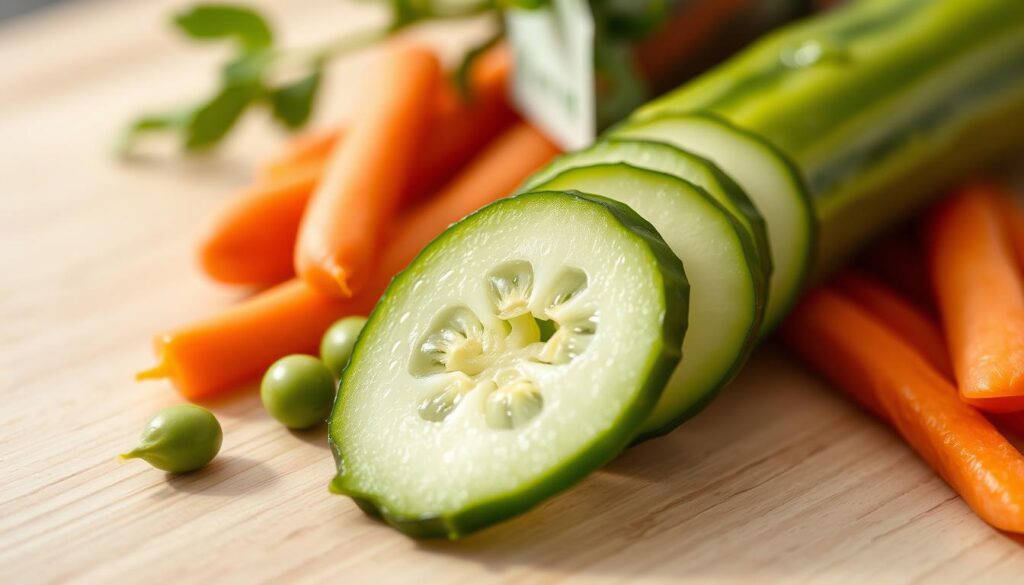
Hydration Benefits for Cats
Cats don’t always drink enough water, which can be a problem. Cucumbers can help them stay hydrated, especially when it’s hot or they’re not drinking enough. Drinking enough water is key for digestion and keeping cool.
Safe Serving Methods
Before giving cucumbers to your cat, wash them well to get rid of pesticides. It’s best to peel them because cats might have trouble digesting the skin. Cut the cucumber into small pieces or serve it as a thin slice. Always watch for any bad reactions when introducing new foods.
What veggies can cats eat? Broccoli: Nutrient-Dense Veggie for Cats
What veggies can cats eat that offer vitamins and fiber? Broccoli is a great way to add both to a cat’s diet. Even though cats are meat-eaters, some veggies like broccoli can be good for them. They help keep cats healthy.
Antioxidant Properties
Broccoli is full of antioxidants. These help protect cats from damage and stress. The vitamin C and beta-carotene in broccoli are key. They help keep cats feeling their best.
Preparation to Avoid Digestive Issues
To add broccoli to a cat’s diet safely, you need to prepare it right. Steaming or cooking broccoli makes it easier for cats to digest. Also, chop it finely to avoid choking.
| Preparation Method | Benefits |
|---|---|
| Steaming | Retains nutrients, easy to digest |
| Cooking | Softens the vegetable, reduces choking risk |
| Chopping finely | Prevents choking, ensures even digestion |
By adding broccoli to their diet in a safe way, cat owners can give their pets a boost. It’s a nutrient-rich food that supports their health.
Source: https://www.chewy.com/education/cat/food-and-nutrition/vegetables-cats-can-eat
What veggies can cats eat? Zucchini: Gentle on Sensitive Stomachs
What veggies can cats eat if they have sensitive stomachs? Zucchini is a great choice. It’s full of nutrients and easy to digest. This makes it a safe and healthy option for their meals.
Digestive Benefits
Zucchini has lots of water and fiber, which helps with digestion. The fiber helps move food through the digestive system. It also has antioxidants that protect cells.
- Supports healthy digestion
- Aids in preventing constipation
- Rich in antioxidants
Cooking Methods for Cats
To make zucchini better for cats, cook it. Steaming is best because it keeps the nutrients. Just slice it, steam until soft, and cool before giving it to your cat.
| Cooking Method | Benefits |
|---|---|
| Steaming | Preserves nutrients, easy to digest |
| Boiling | Softens zucchini, but may lose some nutrients |
Adding cooked zucchini to your cat’s diet is a smart move. It’s nutritious and helps their health.
Source: https://www.lovenala.com/blogs/nalas-blog/6-of-the-healthiest-vegetables-for-cats
What veggies can cats eat? Winter Squash: Fiber-Rich Alternative
What veggies can cats eat that are rich in fiber and nutrients? Winter squash is a fiber-rich vegetable that can provide several health benefits to cats when prepared correctly. It’s a nutrient-dense food that can be a valuable addition to their diet. It offers essential vitamins and minerals.
Nutritional Profile for Feline Health
Winter squash is rich in vitamins A and C, potassium, and fiber. This makes it a nutritious option for cats. The fiber helps with healthy digestion, and the vitamins and minerals boost overall well-being. As a cat-friendly vegetable, it’s a great way to add variety to their meals.
Proper Preparation Techniques
To prepare winter squash for cats, cook it thoroughly to make the nutrients more accessible. Bake or boil the squash until it’s soft, then remove the skin and seeds. Mash or puree the cooked squash to make it easier for your cat to digest.
Serve it plain, without any seasonings or additives, to ensure it’s safe for consumption. As a feline-friendly veggie, cooked winter squash can be a healthy treat when given in moderation.
Source: https://www.sunvetanimalwellness.com/2017/04/greens-cats-ashevilles-natural-veterinarian/
What veggies can cats eat? Peas: Small but Mighty Nutrition
What veggies can cats eat that are small but packed with nutrition? Peas are tiny but full of nutrients good for cats. They offer essential vitamins and minerals that can boost a cat’s diet.
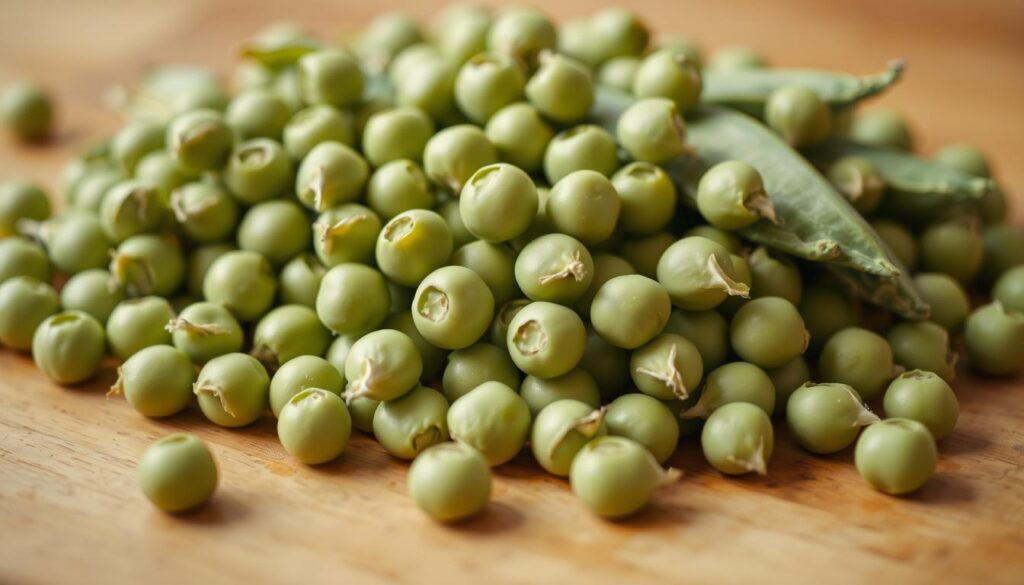
Protein and Vitamin Content
Peas are high in protein and vitamins like K and C. These help keep cats healthy, from their skin to their immune system.
- Protein content: Supports muscle health and overall feline well-being.
- Vitamin K: Essential for blood clotting and bone health.
- Vitamin C: Acts as an antioxidant, supporting immune function.
Fresh vs. Frozen for Cats
Both fresh and frozen peas are safe for cats. But, it’s key to prepare them right to prevent digestive problems.
Fresh peas need to be shelled and cooked for easy digestion. Frozen peas should be thawed and can be eaten raw or lightly cooked. Make sure to skip any seasonings or oils that could harm cats.
Source: https://www.lovenala.com/blogs/nalas-blog/6-of-the-healthiest-vegetables-for-cats
What veggies can cats eat? Sweet Potatoes: Beta-Carotene Boost
What veggies can cats eat that provide essential nutrients? Sweet potatoes are a great choice for cats because they are full of nutrients. They are packed with beta-carotene, which turns into vitamin A in the body. Vitamin A is key for a cat’s health.
Source: https://www.thesprucepets.com/can-cats-eat-sweet-potato-8727834
Health Benefits for Cats
Adding sweet potatoes to a cat’s diet can be very beneficial. Beta-carotene in sweet potatoes turns into vitamin A. This vitamin is vital for a cat’s vision, immune system, and skin.
Vitamin A also makes a cat’s coat shiny and healthy. Sweet potatoes also have fiber, which helps with digestion. A healthy digestive system is important for a cat’s overall health.
Cooking Requirements for Safety
To make sweet potatoes safe for cats, they need to be cooked. Raw sweet potatoes can upset a cat’s stomach. Cooking sweet potatoes makes them easier to digest.
It’s best to bake or boil sweet potatoes until they’re soft. Let them cool before giving them to your cat. Make sure to remove any harmful skin or additives.
How to Introduce Vegetables to Your Cat’s Diet
Introducing vegetables to your cat’s diet should be done slowly. Quick introduction can upset their stomach. Start with small amounts and watch how they react.
Start Slow and Small
Start by adding a tiny bit of a single vegetable to their meal. For example, try a teaspoon of cooked, mashed pumpkin or a few steamed green beans. This slow start helps you see how they like it.
Key considerations when introducing new vegetables:
- Choose one vegetable at a time.
- Start with a small amount, like 1 teaspoon.
- Mix it with their usual food.
Monitoring for Adverse Reactions
Watch your cat closely after introducing a new veggie. Look for signs like vomiting, diarrhea, or feeling very tired. If you see any of these, stop the veggie and talk to your vet.
Common adverse reactions to watch for:
| Symptom | Possible Cause | Action |
|---|---|---|
| Vomiting | Digestive upset | Stop the vegetable, consult a vet |
| Diarrhea | Intolerance or allergy | Discontinue, seek veterinary advice |
| Lethargy | Adverse reaction or intolerance | Stop the vegetable, consult a vet |
Vegetables to Avoid: Keeping Your Cat Safe
Some vegetables can harm your cat’s health. It’s important to know which ones to stay away from. While cats mainly eat meat, they can sometimes eat safe veggies. But, some veggies can really hurt them.
Toxic Vegetables for Cats
There are veggies that are bad for cats and should never be given to them. Onions and garlic are very harmful. They can hurt a cat’s red blood cells and cause anemia. Onions and garlic are toxic in any form.
Also, wild mushrooms are dangerous for cats. Some can even be deadly. Rhubarb is another veggie to avoid because it has oxalic acid, which is toxic.
Signs of Vegetable Toxicity in Cats
If your cat eats a toxic veggie, watch for signs of trouble. Look for vomiting, diarrhea, tiredness, and not wanting to eat. In serious cases, they might have trouble breathing, shake, or even have seizures.
If you think your cat ate something bad, get help from a vet right away. Quick action can help your cat get better.
Conclusion: Balancing Your Cat’s Diet with Healthy Vegetables
Adding safe vegetables to your cat’s diet can be very beneficial. Vegetables like carrots, pumpkin, and green beans are good for them. They help with digestion and can even help with weight management.
When you add new veggies, start with a little bit. This helps avoid any bad reactions. It’s also important to know which veggies are safe and which are not.
Adding the right veggies to your cat’s diet can make them healthier. Spinach, cucumber, and sweet potatoes are great options if you prepare them right.
Knowing how to add veggies to your cat’s diet can really improve their life. By choosing the right ones and introducing them slowly, you can give them a better diet.

